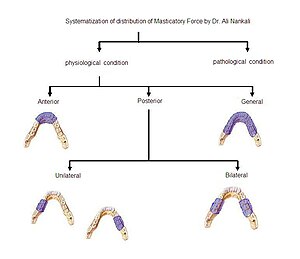User:Ali nankali/Nankali's Masticatory Force Systematization
The Nankali’s systematization of distribution of the Masticatory Force categorize the locations of the forces on different part of mandible/Maxilla, which are important in designing a prosthetic and implant treatment in dentistry.

Masticatory Muscles
[edit]The muscles of mastication or Masticatory muscles and are [1];
a) the masseter, b) temporalis, c) medial pterygoid, d) superior belly of the lateral pterygoid, e) the anterior digastrics, f) geniohyoid, g) mylohyoid h) and inferior belly of the lateral pterygoid.
Measuring Masticatory Force
[edit]The Masticatory force initially was measured by Dr. Bleck. Dr. Bleck used a Gnathodynamometer and also found out the close relation between periodontal tissue and Masticatory force.

Dr. Morill worked more deeply on the relation between masticatory muscles and pain signals from the periodontal tissue in different way. [2]
Dr. Shreder, using local anaesthesia (to ignore the periodontal response) measured the maximum possible force of Masticatory system and found out the differences in the produced force, which was approximately doubled. [3]
Periodontal system controls automatically the measure of mastication force in this process and the jaw elevator muscles develop the main forces used in mastication.
Dr. Weber work out that 1 cm2 surface of perpendicular slide of any masticatory muscle can produce approximately 10 Kg force. The following surfaces were found[4]: temporalis - 8 cm2, masseter - 7.5 cm2, and medial pterygoid - 4 cm2. It means, the maximum amount of force can be raised to 3900N in complex.
However, the force generated during routine mastication of food like carrots or meat is about 70-150N. The maximum biting force is around 500-700N. [5];
Dr. Ali Nankali followed a number of act chewing in different individuals using computer. The monitored result of this investigation illustrates constant changes in the amount of masticatory force.[6]. In other words, the masticatory force constantly changes in eating time according to mouthful characteristic and size, which has various affect on the maxilla and mandible via teeth.
He also found the mechanical and bio-physiological relation in the system for producing the Masticatory force. His works shows that the level of force is in direct proportion with its location.
According to this systematization designed, the force of Masticatory is divided in two main groups, with physiological or pathological condition. The physiological Masticatory Force with is divided into three different subgroups acoording to their localizations, anterior, general (covering the entire arch) and posterior part of arch, which is also divided into two different groups; unilateral and bilateral. [7].
This systematization proves that the condition of producing a maximum masticatory force by a person is using the general subgroup of this systematization.
History
[edit]The systematization of Nankali Masticatory Force distribution (Nankali's Masticatory Force Systematization) was designed by Dr. Ali Nankali in the National Medical University at the Orthopedic and Implant Stomatology Department, which (October 1999) verified by Scientific Board of National Medical University (O.O. Bogomolets) and international patent organization (УДК; 616.314-76-77:616.314.11-74:678.029.46:612.311) in Kiev.
For the first time Nankali Masticatory Force systematization was presented at the 55Th Medical Science Conference of Students & Young Scientists in 2000, which was organized by Ukraine Health Ministry and National Medical University known as O.O. Bogomolets and Society Science Students known as O.O. Kisilia. The result of presentation in "Young Scientists and Students / Scientific Medical Seminar in 1999" was published.
Notes
[edit]- ^ Crispian Scully, (2002) Oxford Handbook of Applied Dental Sciences/Oxford University Press –ISBN 978-0-19-851096-3 . P151
- ^ Juliev. E.N.(Жулев Е.Н.)(2000) Fixed prosthetics (Несъемные протезы) / НГМА - Nijnegorodskoi Gosudarstveni Medisinskoi Akademi /Н. Новгород - Novogorad, ISBN 5-7032-0330-9, P53
- ^ Juliev. E.N.(Жулев Е.Н.)(2000) Fixed prosthetics (Несъемные протезы) / НГМА - Nijnegorodskoi Gosudarstveni Medisinskoi Akademi /Н. Новгород - Novogorad, ISBN 5-7032-0330-9, P53
- ^ Abolmasov N.G., Abolmasov N.N., Bichkov B.A., Alkhakim A. (2003). Orthopedicheskaia Stomatalogia. Moscow / Medpress-inform, ISBN 5-901712-25-0, P41
- ^ Crispian Scully, (2002) Oxford Handbook of Applied Dental Sciences/Oxford University Press –ISBN 978-0-19-851096-3 P156
- ^ Nankali A.(2002), Strength Properties Investigation of the hard tissue of the teeth root, Ukrainian Medical Young Scientists Journal,National Medical University, No3-4, Page 74-76.
- ^ Nankali A. (2002) Investigation of strength properties of the hard materials of the tooth roots. Ministry of Public Health of Ukraine / Ukrainian Scientific Medical Youth Journal, Quarterly Scientific Journal No. 33 -, p74-76
References
[edit]- Crispian Scully, (2002) Oxford Handbook of Applied Dental Sciences/Oxford University Press –ISBN 978-0-19-851096-3, P151-156.
- Juliev. E.N.(Жулев Е.Н.)(2000) Fixed prosthetics (Несъемные протезы) / НГМА - Nijnegorodskoi Gosudarstveni Medisinskoi Akademi /Н. Новгород - Novogorad, ISBN 5-7032-0330-9, P151.
- Abolmasov N.G., Abolmasov N.N., Bichkov B.A., Alkhakim A. (2003). Orthopedicheskaia Stomatalogia. Moscow / Medpress-inform, ISBN 5-901712-25-0, P36-47.
- Crispian Scully, (2002) Oxford Handbook of Applied Dental Sciences/Oxford University Press –ISBN 978-0-19-851096-3.
- Nankali A. (2002) Investigation of strength properties of the hard materials of the tooth roots. Ministry of Public Health of Ukraine / Ukrainian Scientific Medical Youth Journal, Quarterly Scientific Journal No. 33 -, p74-76
